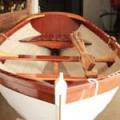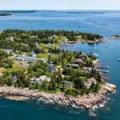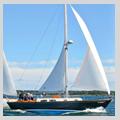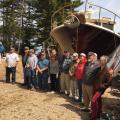View from the Porch - Issue 126
Issue 126
By Peter Bass
Time for that midsummer deep breath, the one that marks the bittersweet moment when we choose to either bemoan that the first half of the season is behind us, or celebrate that the second half is yet to come. It’s the old half-full/half-empty conundrum, although no one wholly falls into either the pessimist or optimist column. It is our human nature to look both forward and back.
This philosophical pondering led me to rummage around for a small, blue textbook of Greek and Roman mythology from prep school so I could look up Janus. I had to go to Wikipedia instead. I really was hoping to find that book and see what I had written in the margins of the sections where the gods and goddesses were lusting around and about.
Deep breath over, let’s get cracking.
More is Better
Some years ago I wrote an April Fools’ Day article for this very magazine about a catamaran-hulled lobsterboat allegedly under construction in North Yarmouth. I engaged a few co-conspirators to give it some appearance of credibility, but included what I thought was an overwhelming number of clues that it was a joke. This included a picture of an old Jonesporter that was manipulated to give it two hulls instead of one—it looked nothing like the profile drawing provided by a noted naval architect.
Well, as the old expression goes, life imitates art—although in this case the true-life effort is serious and the art is my article, even though “art” is a word neither I nor anyone else usually applies to my scribbles. The Working Waterfront recently reported that Stonington-based Penobscot East Resource Center has asked Maine Maritime Academy professor Doug Read to think outside the box and come up with a way to make lobsterboats more fuel-efficient. We have mentioned this project before, although I can’t remember when. In any case, the project has advanced into multihulls and has moved to the tank-testing stage with promising results using a trimaran model. The profile is evocative of a traditional lobsterboat, and the outlying hulls support an enormous cockpit. The model hull they are comparing it to is the Holland 38; if they only could get it to look like that, too. Of course the big question is: in which class will it race?
Go Fish!
We have been following for some time the now-successful effort to get the St. Croix River open to the free passage of alewives. I have been faithfully checking the Internet for updates in hopes that there would be an interview with the first alewife to broach the Grand Falls Dam since 1995. No fish interviews yet, but proponents of opening the river gathered at Grand Falls Dam in early June to celebrate the free passage of fish through that barrier.
As reported in the Bangor Daily News, the long road to reopening the fishway took patience and cooperation among the Native American tribes, state and federal agencies, and non-governmental organizations to get the overwhelming support of the state legislature. The Governor allowed the resulting bill to become law without his signature.
And now for the rest of the story.
Back in mid-May, there was an article in the Working Waterfront by Dr. Heather Deese and Catherine Schmitt talking about little fish and big fish, in particular the alewife and the cod. They pointed out that cod eat what is available, and that when alewives were plentiful there was a steady stream of juvenile alewives headed into the sea from the rivers that feed Passamaquoddy Bay. There were also a lot of cod in Passamaquoddy Bay and inshore all along the Maine coast. I remember fishing in the mouth of the Sheepscot River, not far from Reid State Park, with Capt. Louie Garcelon. We hauled in big cod until we were worn out. We took a few home, and Louie sold the rest. This was in the early 1960s. It would seem likely that an abundance of eels, smelt, and alewives in these river systems must have had an effect on the big fish.
That interview with the first alewife to get over Grand Falls Dam might have gone something like this: “After bumping my nose on that board with George Smith’s name on it (see previous issue) for a few years, I finally made it over the dam. Now, if you’ll excuse me, I have a lot of spawning to catch up on. Yippee!”
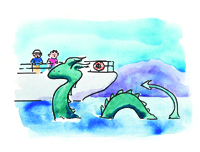 All illustrations by Ted Walsh
All illustrations by Ted Walsh
One of our porch regulars was once an underwriter for a major insurer. He worked with the actuaries, who are probability analysts; they run computer models to predict risk but don’t have the social skills to be accountants. I wonder if this risk was run through the actuarial department; if it was, those guys will be talking about it for years.
It’s Alive!
Time for another Mel Brooks movie, perhaps this time about genetically modified Atlantic salmon, often referred to as Frankenfish. Developed by a company named AquaBounty, the trademarked AquaAdvantage salmon has had a gene from a Chinook salmon spliced into it. This gene acts like the override switch on a light timer. Evidently the growth hormone in Atlantic salmon that tells the fish “time to bulk up” is only in the “on” position for part of the year. The Chinook gene throws the switch into the “on” position all year round.
The pictures of AquaAdvantage salmon online are impressive. While an 18-month-old fish without the gene weighs about three pounds, Frank weighs over six, and he got to that weight with a lot less feed. More pounds of salmon at a lower cost, deemed safe by the infallible FDA. What could be wrong with that?
Nothing at all, according to AquaBounty (aquabounty.com), or a lot, according to the anti-genetically-modified-food guardians. Here in Maine, according to an article in the Ellsworth American, farming GM salmon has been illegal for years, and a state representative has introduced legislation to require any GM salmon sold in Maine to be marked with a special label. If that passes, I hope the label bears a likeness of Peter Boyle’s character in Mel Brooks’s Young Frankenstein.
It turns out that a lot of practices in aquaculture that are designed to modify qualities such as growth rate or disease resistance, fall outside the GM definition. The bill in question is being re-written to make the definition of “genetically modified” less broad, so as not to sweep up in its regulatory net other farmed organisms, such as oysters.
I hope my reading of the science is close enough; I am sure my limited understanding of biology is sticking out all over the place. Would that science rules the day, and a less-expensive source of high-quality protein is not outlawed for the wrong reasons. We can’t all afford to shop at Whole Foods.
We Jammin’
The High Season on the coast is bookended by two festivals that bring most of the schooner fleet together: Boothbay Harbor Windjammer Days in late June, and the Camden Windjammer Festival over Labor Day weekend. As I write this Boothbay is a couple of weeks away; as you read it, Camden is still to come.
These events are Maine’s mini-OpSails; a chance to imagine the New England coast in the days of sail. There is a photo in our cottage in Boothbay of an unidentified New England harbor with dozens of schooners at anchor or getting under way. They were the 18-wheelers of their day, the towns and cities of New England were their terminals, truck stops, and repair shops.
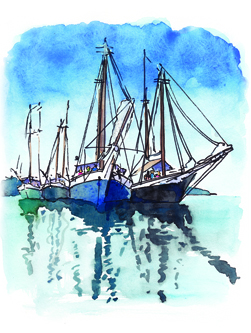 All illustrations by Ted Walsh
All illustrations by Ted Walsh
Reading the schedule for the Camden event reminded me that things are happening all over the state all summer long. I found a fairly comprehensive compilation of events on line at visitmaine.com, although there are some events I know of that are not listed. I think it would be possible this year to attend festivals 4 or 5 days a week through the entire summer and do it again next year without having to repeat.
Perhaps this magazine should rent a big RV and go to as many festivals as possible and write about the quest. Top choice? I would cast a vote for the Wilton Blueberry Festival in early August. (www.wiltonbbf.com). Check it out.
Back to Camden and the age of sail. There’ll be plenty to see, eat, buy, do, and hear. Get one last sunburn and a few thousand extra calories. More information at camdenwindjammerfestival.org.
Climate Change is Good
Climate change is affecting many aspects of our lives and has the potential to shift patterns of commerce in the years ahead. Maine could very well benefit from the latter. For instance, we have talked a couple of times about the Northwest Passage and how increasingly common high-latitude transits have become for vessels of all kinds. Now some visionaries are looking in the other direction. Thanks to the shrinking ice pack, it seems that the Northeast Passage, through the Arctic Ocean across the top of Russia to Asia, is now a viable trade route. It is 40 percent shorter than sailing through the Mediterranean and the Suez Canal, plus there are no Somali pirates.
In a Bangor Daily News article about a trade mission to Portland by Iceland’s President, Olafur Grissom, the writer noted that the northeast route is already being used by commercial vessels. President Grissom, in an address to Maine’s trade community, said Maine and Iceland are in a position to benefit from this new route. In fact Eimskip, an Icelandic shipping company, has recently relocated its North American headquarters to Portland from Norfolk, Virginia, and is now providing direct container service between Northern Europe and Maine. Portland was chosen thanks to infrastructure improvements at the Portland terminal. The challenge for Maine will be to continue to make infrastructure improvements in the future, so it can function as a major port of entry in a decade.
The visionary chat by President Grissom may plant the seeds for something positive to come from the shrinking Arctic ice pack. Just because we see—and bemoan—the effects of global warming does not mean we should dismiss the opportunities it presents.
That’s all for rambles and rants from the porch. Now we need to get back to the real mission of the porch regulars: monitoring boat traffic for nautical irregularities. Things are a little quiet as I write, but by the time this is in your hands I can imagine the fun we will be having.
Speaking of fun, it’s time for the part you’ve been eagerly awaiting:
Now the weather’s finally warm
When you make your favorite dish
That requires a larger fish
Don’t forget to praise the life
Of smelt, of herring, and alewife.
Maine in spring and early summer
We know the salmon ate the smelt
Whose total numbers have been dealt
A blow that the salmon feel
Like stripers with the shrinking eels.
Just because I wax poetic
Cod we know are omnivores
Could it be they came near shore
To feast upon the steady flow
Of alewives off to sea to grow?
Just because I wax poetic
The Arctic ice may further shrink
Don’t despair, but rather think
Of opportunities here already
Feet up, binoculars at the ready.

Long-time MBH&H Contributing Editor Peter Bass is a freelance writer and raconteur who divides his time between porches in Maine and Virginia. Click here to read other articles by Peter Bass » To submit your comments... newsy tidbits, photos, illustrations, clippings, rants, and raves for possible use in this column, use the form below. Or mail to “View From the Porch,” P.O. Box 566, Rockland, ME 04841 or fax to 207-593-0026. Items may be edited for length and clarity; materials become the property of Maine Boats, Homes & Harbors, Inc.
It would seem likely that an abundance of eels, smelt, and alewives in these river systems must have had an effect on the big fish.
Bigger Fish
While we are on the subject of big fish, one of the editors at MBH&H forwarded an interesting piece from the UK’s Daily Mail. This article concerned the decision of a company, Jacobite Cruises, to add insurance coverage to their cruise ships for damage that might be caused by a close encounter with the Loch Ness monster.
Hoping to find some insight for deciding whether or not this coverage was a prudent consideration of risk or simply a great piece of marketing, I went to Wikipedia to refresh my Jacobite history. I discovered the only thing that Jacobite Cruises and the effort to return the Stuarts to the throne of England in 1688 have in common is that they were both based in Scotland.
Jacobite Cruises owns three vessels and carries 10,000 passengers a year on sightseeing cruises on Loch Ness. The owner of the company, a Ms. Freda Newton, and her insurance agent are making the risk-management argument in the press, which includes national papers like the Daily Mail. I think that, in addition to the obvious publicity they have ginned up for a nominal cost, they have given their boat crews the perfect answer to what must be an endless stream of inane questions from tourists: “No madam, I am not sure if the monster exists or if we shall see her today. All I can tell you is that we take her seriously enough to carry a million pounds of insurance coverage in case of an encounter.” All illustrations by Ted Walsh
All illustrations by Ted Walsh All illustrations by Ted Walsh
All illustrations by Ted Walsh
Long-time MBH&H Contributing Editor Peter Bass is a freelance writer and raconteur who divides his time between porches in Maine and Virginia. Click here to read other articles by Peter Bass » To submit your comments... newsy tidbits, photos, illustrations, clippings, rants, and raves for possible use in this column, use the form below. Or mail to “View From the Porch,” P.O. Box 566, Rockland, ME 04841 or fax to 207-593-0026. Items may be edited for length and clarity; materials become the property of Maine Boats, Homes & Harbors, Inc.
Related Articles
Share this article:
2023 Maine Boat & Home Show

Join Us for the Maine Boat & Home Show!
Art, Artisans, Food, Fun & Boats, Boats, Boats
August 11 - 13, 2023 | On the waterfront, Rockland, Maine
Click here to pre-order your tickets.
Show is produced by Maine Boats, Homes & Harbors magazine.







